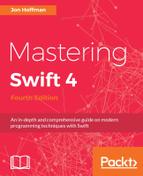All good computer books that are written to teach a computer language have a section that shows a user how to write a Hello World application. This book is no exception. In this section, we will show you how to write two different Hello World applications.
Our first Hello World application will be a traditional Hello World application that simply prints Hello World to the console. Let's begin by creating a new Playground and naming it Chapter_1_Hello_World.
In Swift, to print a message to the console, we use the print() function. In its most basic form, we would use the print function to print out a single message, as shown in the following code:
print("Hello World")
Usually, when we use the print() function, we want to print more than just static text. We can include the value of variables and/or constants by using string interpolation or by separating the values within the print() function with commas. String interpolation uses a special sequence of characters, ( ), to include the value of variables and/or constants in the string. The following code shows how to do this:
var name = "Jon" var language = "Swift" var message1 = " Welcome to the wonderful world of " var message2 = "(name), Welcome to the wonderful world of (language)!" print(message2) print(name, message1, language, "!")
We can also define two parameters in the print function that change how the message is displayed in the console. These parameters are the separator and terminator parameters. The separator parameter defines a string that is used to separate the values of the variables/constants in the print() function. By default, the print() function separates each variable/constant with a space. The terminator parameter defines what character is put at the end of the line. By default, the newline character is added at the end of the line.
The following code shows how we would create a comma-separated list that does not have a newline character at the end:
var name1 = "Jon" var name2 = "Kim" var name3 = "Kailey" var name4 = "Kara" print(name1, name2, name3, name4, separator:", ", terminator:"")
There is one other parameter that we can add to our print() function. This is the to: parameter. This parameter will let us redirect the output of the print() function. In the following example, we redirect the output to a variable named line:
var name1 = "Jon" var name2 = "Kim" var name3 = "Kailey" var name4 = "Kara" var line = "" print(name1, name2, name3, name4, separator:", ", terminator:"", to:&line)
Previously, the print() function was simply a useful tool for basic debugging but now, with the new enhanced print() function, we can use it for a lot more.
